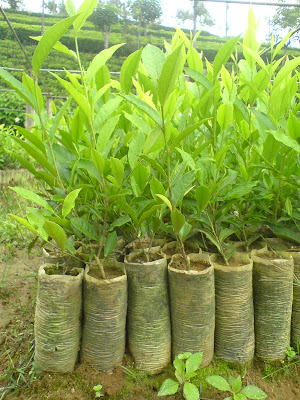Fertilizer for tea nursery is not meant for fast and high growth in green foliage. It should be focused on the development of the frame of the young tea plant, since; a sustainable crop could not get from a bush with a poorly developed frame of the plant. The formulation of the tea nursery fertilizer mixtures have been done with that scope in mind.
Basically there are two tea nursery mixtures used in Sri Lanka, namely T65 (MAP) (P-source is mono-ammonium phosphate) and T65 (DAP) (P-source is di-ammonium phosphate). Apart from the market availability, it doesn’t matter to use MAP or DAP for the mixture. But, T65 (MAP) dissolves fast, so that, it is easier to handle.
Composition of T65 (MAP) Mixture
Parts by weight | Chemical name of the ingredient | Nutrient content |
15 | Sulphate of Ammonia | 20.6% of N |
20 | Mono-Ammonium Phosphate (MAP) | 20% of N and 35% of P2O5 |
15 | Sulphate of Potash | 48% of K2O |
15 | Epsom Salt | 16% of MgO |
65 (Total Parts) | ||
T65 (MAP) mixture contains 10.9% N, 10.8% P2O5, 11.1% K2O and 3.7% MgO
Composition of T65 (DAP) Mixture
Parts by weight | Chemical name of the ingredient | Nutrient content |
20 | Sulphate of Ammonia | 20.6% of N |
15 | Di-Ammonium Phosphate (DAP) | 18% of N and 46% of P2O5 |
15 | Sulphate of Potash | 48% of K2O |
15 | Epsom Salt | 16% of MgO |
65 (Total Parts) | ||
T65 (DAP) mixture contains 10.5% N, 10.6% P2O5, 11.1% K2O and 3.7% MgO
There is no need to use exactly the same mixtures mentioned above, to a tea nursery, but be sure the nutrient content and composition is approximately the same, as indicated.
How to apply the nursery fertilizer mixture to a VP tea nursery (in polythene bags)
Tea nursery fertilizer mixture is a foliage application with watering cans. If you use T65 (DAP), it should be ground well and make a paste, before dissolving it in water, since DAP is poorly dissolve in water.
It is not advisable to apply fertilizer to the young plant, or planted shoot cuttings, before the roots are emerged. Therefore, the time of the first application of fertilizer is, after 2-3 months of planting.
Dissolve 35 g of above mixture in 5L of water and apply it onto, approximately 1 m2 of the tea nursery, in fortnightly intervals. Generally, with 4 inch diameter polythene bags, 1 m2 contains 120 nursery plants.
In about 5-6 months after planting of shoot cuttings in nursery bags, increase the weight of fertilizer up to 70 g/5L water/m-2 of nursery area.
Note that, it is compulsory to wash off the fertilizer mixture from foliage with clean water within 15-30 min time, to avoid scorching the leaves due to high concentration of fertilizer.
Application of Zinc Sulphate (ZnSO4) to induce bud break in tea nurseries
Branching is important in tea bush because, the higher the number of branches, higher would be the number of shoots harvested. Also, branching must be induced from the lower parts of the main stem of the bush, so that, they would not be cut off in seasonal pruning of branches. Therefore, induce of branching from the base of the main stem is commenced from the nursery stage.
Foliar application of ZnSO4 is done to induce bud break at the nursery stage. One week after each application of T65, 14 g of ZnSO4 is dissolved in 4.5L of water and spray this with a Knapsack (hand) sprayer to approximately 4500 (38 m2) nursery plants. Repeat the application at 4-6 week intervals up to 4 applications per year.
Click her to view fertilizer for Seedling Tea Nursery
Click her to view fertilizer for Seedling Tea Nursery
Well grown Tea (VP) Nursery Plants


No comments:
Post a Comment